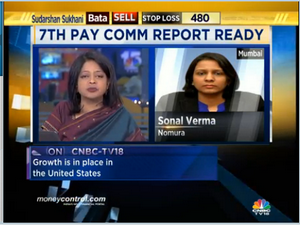15% salary hike in 7th CPC while 6th CPC granted up to 40%

15% salary hike expected in 7th CPC report while 6th CPC granted up to 40% – Video report of CNBC TV18
 The Seventh Pay Commission report is likely to submitted to the Finance Ministry on Thursday, says the sources. However, the government employees and pensioners are in for disappointment as the report is expected to propose a 15 percent hike in salaries starting January 1, 2016.
The Seventh Pay Commission report is likely to submitted to the Finance Ministry on Thursday, says the sources. However, the government employees and pensioners are in for disappointment as the report is expected to propose a 15 percent hike in salaries starting January 1, 2016.
Sonal Verma of Nomura says the indicated 15 percent hike would be much lower than the expected 35 percent that was given in 2008. She adds that the government, on its part, would try to balance the expenses with it trying to retain its fiscal deficit target of 3.5 percent of GDP for this year.
Verma believes the seventh pay commission will boost demand and sale in consumer durables such as cars, two-wheelers and electronics.
Pay commissions review the salary structure of central government employees every ten years. Below is the verbatim transcript of Sonal Verma’s interview with Latha Venkatesh on CNBC-TV18.
Q: From what you have picked up, what are you expecting that the recommendations will do to the economy?
A: I think the news reports are talking about a 15 percent increase which is significantly lower than what the 6th pay commission had recommended which was close to a 40 percent increase in salaries. The extent of increase is actually on the lower side of expectations. Nevertheless in terms of the economic impact, there are two-three things to keep in mind.
One is the fiscal impact. If it is indeed 15 percent then the fiscal impact which is typically spread out over two years, both in FY17 and FY18, because the recommendations will be taken into account when the next Budget is presented as salaries have to be increased from January 1 2016, the fiscal impact in the first year and the second year combined most likely is going to be around 0.1-0.2 percentage points. To put this in comparison the 6th pay commission impact was close to 0.4-0.5 percentage points just in the year one alone. There was another 0.3 percentage points impact in the second year.
Second is typically what we have seen is that states implement their own pay commission once the center releases it. The state employees allot more and government employees as compared to the central government. So, the impact on the central government employees and pensions, etc together is about 8 million people as compared to state governments which employees close to 12 million or so people. So, we should be seeing more state governments implementing it in the next year.
Also, I think this is clearly consumption bonus therefore typically demand for discretionary items like cars and other white goods tends to pick up which is something we should expect as well. Obviously the key challenge for the government is how do you balance the fiscal because you do know that in FY17 the fiscal deficit target is 3.5 percent of gross domestic product (GDP). So, we have one rank one pay (OROP), we have the 7th pay commission on the lower side but nevertheless it is an additional expenditure. So, there has to be some strategy to balance some of the expense items that they now have to pay for.
Q: The long in the short of what you are saying is that the consumption boost is not going to be as much as the markets and the economists were preparing?
A: I would think so. I think the inflation linked, the earners’ allowance increase has been going on every year. So, this is basically the real increases in salaries which over the 10-year period is a 15 percent increase. So, it is like 1.5 percent real rate increase. So, typically like I said, most of our recent memories for the 6th pay commission where the hike was close to 40 percent so I would say the extent of increase is on the lower side of expectations. Nevertheless it is an increase and therefore it will lead to some increase in consumption no doubt.
Source: moneycontrol.com
Another coverage of CNBC TV18 on 7th Pay Commission Report



